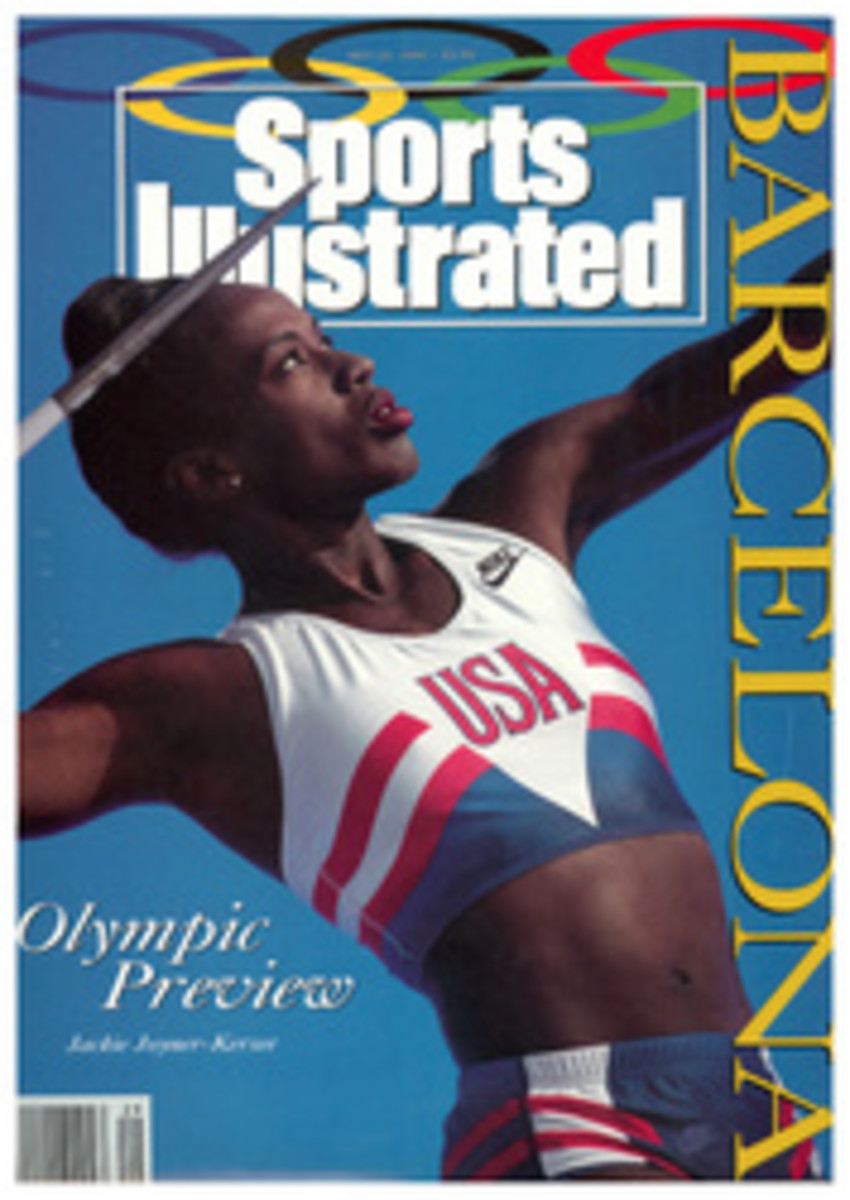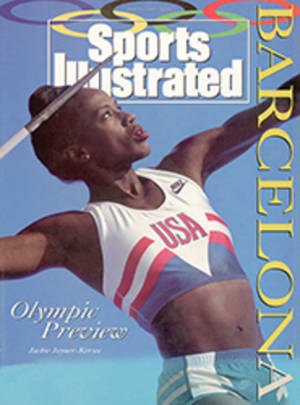
Blades And Wheels
The competitors are poised at the starting line and motionless until the gun. Then they're off, eyes fixed straight ahead, Lycraswathed thighs pumping rhythmically. They hold fast to any aerodynamic advantage as they fly around the oval, knowing that milliseconds can mean the difference in winning a medal....
Or, in the case of some athletes, two medals. Let's play the tape again. If the scene unfolds at a Winter Olympics, the race determines the finest speed skaters in the world. When it evolves at the Summer Games, it sorts out the world's best track cyclists. Again and again since the late 19th century, a number of athletes have earned worldwide distinction in both sports, flashing blades or sitting astride a bike, depending on the season.
Cycling's links with speed skating are many. Just like a skater negotiating an iced track, a match sprint, pursuit or time-trial cyclist has to develop explosive speed out of a still position, endurance to maintain the agonizing pace, a knack for sensing lap times and the reserve to sprint to the finish. Speed skaters actually refer to the racing position—body bent forward at the waist, hips angled, back parallel to the ice—as "sitting." Few cyclists train by speed skating, but most speed skaters cycle as part of their off-season regimen, even if they don't cycle competitively.
Of course in skating there is no seat to settle into, and that's one reason those who have plied both sports consider skating tougher. "Skating is such a technical sport that it's very difficult to acquire a high level of skill at an older age," says Connie Paraskevin-Young, who skated for the U.S. in the 1980 and '84 Winter Games, rode to a bronze medal in the match sprint at the Seoul Olympics in 1988 and will be competing in that event in Barcelona as well. Because of those precise technical demands, it's much more common to find an ex-skater cycling than an ex-cyclist skating. "In cycling you're relying on a machine to do much of the work for you," says Paraskevin-Young. "You can reach a certain level simply by being fit."
Adds the Netherlands' Bart Veldkamp, who won the speed skating gold medal in the 10,000 meters in the 1992 Winter Olympics in Albertville and will be in Barcelona as a member of Holland's 4,000-meter pursuit team, "The secret to skating is how deep within you you can go for the last few laps while still maintaining your technique. Cycling is more mindless. In a criterium I get bored after 15 minutes."
The circumstances of skating, too, require a hardier constitution. "My toes froze so many times I couldn't feel them," says Paraskevin-Young. "Certainly I had a work ethic instilled in me a long time ago that carried over. And I'd have to say that in some cycling circles, I don't see that same work ethic."
Among the cyclists in Barcelona who will be drawing on their character-forging experience on ice:
•Paraskevin-Young, 31, is a four-time world champion in the match sprint. During three of those championship years (1982, '83 and '84) she also held at least one national speed skating title. "I still consult with one of my skating coaches [at the Wolverine Sports Club in suburban Detroit]," Paraskevin-Young says. "I don't do much training on ice anymore, but I still do a lot of workouts off-ice that I began doing for skating. At first, cycling people would say, 'Are you nuts?' I've won four world championships, so I can't be too crazy."
•Veldkamp, 24, could make history in Barcelona. That's because with the Winter and the Summer Games henceforth set to alternate at two-year intervals, he could be the last person to win a medal in two Olympics in the same year.
•Ingrid Haringa, a 28-year-old policewoman from the Dutch town of Velzen, skated competitively until 1989, when she finished fourth overall at the world championships. She's a favorite in the match sprint after winning two world cycling titles last summer, victories that shocked the bicycle cognoscenti, who evidently hadn't allowed for the 13 years Haringa spent on a bike as part of her skating training.
It is no accident that two of the athletes mentioned above are from tiny Holland. Nearly a quarter of that country's 15 million people consider themselves serious cyclists, and about 15% of them style themselves serious skaters. "I'm told that in some countries they call off school when it gets too hot," says Mart Smeets, a broadcaster with Dutch television. "Here, school lets out when it's cold enough for the canals to freeze over. If you ask my 12-year-old son who Hans Brinker is, he won't know. Hans Brinker is for tourists. But my son can skate. Skating and cycling, they are the Dutch diseases."
One of Holland's greatest folk heroes is Dries van Wyhe, a flinty character who in 1974 beat every member of the '72 Dutch Olympic cycling team to become national road champion. Seventeen years later, even more improbably, he won the national speed skating championship in the 200-km marathon at age 42. As it happens, Van Wyhe was too quirky a fellow to follow the disciplines of being part of an Olympic team, either as a skater or as a cyclist; he never accepted offers to turn professional, because pro cyclists train and race on Sundays and Van Wyhe took literally the Biblical injunction about the seventh day. Smeets says Van Wyhe "always makes you laugh because he's so weird. He's the Yogi Berra of Holland."
Another Dutchman who excelled in both sports, albeit not at the Olympics, was Jaap Eden. A squat man with a Herschel Bernardi mustache, Eden won world speed skating titles in 1893, '95 and '96, and world cycling titles in 1894 and '95, before going on to be a deliveryman for a printer. A very prompt deliveryman, no doubt.
The original American man for all seasons, Art Longsjo, became the U.S.'s first same-year dual Olympian in 1956, although he didn't do too well—14th as a team pursuit cyclist and 40th as a 5,000-meter speed skater. Sheila Young—whose brother, U.S. national sprint coach Roger Young, is Paraskevin-Young's husband—fared much better. She won three Olympic skating medals in 1976 but had to settle for a world championship in sprint cycling the following summer because women's cycling hadn't yet been added to the Olympic program. Then there's Connie Carpenter-Phinney, who skated to a seventh-place finish at the Sapporo Games in 1972 in the 1,500 meters and won the gold medal in the road race at the 1984 Los Angeles Olympics, which means that Paraskevin-Young is not the only hyphenated American Connie to compete in both Olympics.
Two even more prominent American athletes, siblings Beth and Eric Heiden, made the more unusual transition from skating to road, rather than track, cycling: Several months after winning a bronze medal at the 1980 Winter Games, Beth became world road-racing champion; Eric, who won five skating golds at Lake Placid, barely missed making the 1980 Olympic cycling team and rode in the 1986 Tour de France.
More recently Christa Rothenburger Luding did what Veldkamp will try to do. In 1988, competing for East Germany, she won Olympic medals in both the Winter Games (a silver in the 500 meters and a gold in the 1,000) and the Summer Games (a silver in the match sprint). She retired last February, after winning a bronze in the 500 meters in Albertville. Through Luding's prime as a cyclist her secret was the "long sprint." Most three-lap match sprints aren't actually sprints until the final lap, so Luding would sometimes surprise a rival by taking off several hundred meters early—something she credited to the stamina she developed as a 1,000-meter skater.
Even the vaunted East German sports machine was slow to realize how easy it would be to double its medals. In 1985 a journalist offhandedly mentioned to the then Christa Rothenburger, who was already a world champion and Olympic gold medal speed skater, that she would surely place in the top six at the World Cycling Championships if only she would enter. When she broached the possibility with several sports apparatchiks, they were aghast. "You should concentrate on speed skating," they harrumphed. "We don't need a cyclist." Only when she personally petitioned Manfred Ewald, the president of East Germany's gymnastics and sports federation, was she allowed to seriously pursue the sport she had taken up for cross-training. The bureaucrats whose heads she had gone over made her life miserable, banning her coach and husband-to-be, Ernst Luding, from traveling with her in 1986 to Colorado Springs, where she won her first world sprint cycling title. "Some officials were happy," remembers Luding, "but others had hoped I would finish last."
Indeed, both the cycling and skating worlds can be clannish, which sometimes leaves the two-sport athlete caught in the middle. Dede Demet, who spent four years on the U.S. speed skating team and was world junior road-racing champion in 1989, noticed considerable jealousy on the part of speed skating types. "The national team coaches didn't seem to like that I was involved in cycling," she says. "They never really said anything, but you could tell." Demet placed 12th in the Olympic road-racing trials this season, but at age 19 she's able to look hopefully ahead to 1996.
Because the influx of skaters into cycling is greater than traffic in the other direction, resentment tends to run even deeper among officials in cycling than it does among those in skating. It was because of such ill will that Veldkamp qualified for the Dutch cycling team only after much unseemly political wrangling. "The coach sees me as an intruder, not as an Olympic veteran with valuable experience," says Veldkamp. Although he intends to keep skating competitively, Veldkamp is inclined to give up cycling rather than put up with further aggravation.
How best to improve relations between the two sports? One solution might be to get talent flowing the other way, by persuading more young cyclists to take up skating—roller blading already is being used as a cross-training method by some cyclists—as a "hobby," as another two-sport athlete of note, Bo Jackson, might put it. That might make cycling pooh-bahs less inclined to regard ex-skaters as interlopers, and skating muckamucks less likely to look at skaters who take up cycling as turncoats. Whether that oval is iced or not, it's tough enough getting around it without someone in a blazer impeding your progress.
Any riders up to the challenge, please note: The Winter Games in Lillehammer are only 18 months away.
PHOTO ILLUSTRATION
TOM LYNN/DIGITAL; GUY A. FERY
Skaters like Paraskevin-Young are in perfect position to transform themselves into bike people.
PHOTO
RIEN ZILVOLD/TRANSWORLD FEATURES
With cycling and skating titles 17 years apart, Van Wyhe is a man for two eras as well as two seasons.

